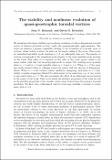Files in this item
The stability and nonlinear evolution of quasi-geostrophic toroidal vortices
Item metadata
| dc.contributor.author | Reinaud, Jean Noel | |
| dc.contributor.author | Dritschel, David Gerard | |
| dc.date.accessioned | 2019-07-21T23:41:28Z | |
| dc.date.available | 2019-07-21T23:41:28Z | |
| dc.date.issued | 2019-03-25 | |
| dc.identifier | 256888764 | |
| dc.identifier | 8fdd4ac8-a5af-423c-8752-57e71cb27180 | |
| dc.identifier | 85060366607 | |
| dc.identifier | 000458502400001 | |
| dc.identifier.citation | Reinaud , J N & Dritschel , D G 2019 , ' The stability and nonlinear evolution of quasi-geostrophic toroidal vortices ' , Journal of Fluid Mechanics , vol. 863 , pp. 60-78 . https://doi.org/10.1017/jfm.2018.1013 | en |
| dc.identifier.issn | 0022-1120 | |
| dc.identifier.other | ORCID: /0000-0001-5449-6628/work/53214493 | |
| dc.identifier.other | ORCID: /0000-0001-6489-3395/work/64697796 | |
| dc.identifier.uri | https://hdl.handle.net/10023/18145 | |
| dc.description.abstract | We investigate the linear stability and nonlinear evolution of a three-dimensional toroidal vortex of uniform potential vorticity under the quasi-geostrophic approximation. The torus can undergo a primary instability leading to the formation of a circular array of vortices, whose radius is approximately the same as the major radius of the torus. This occurs for azimuthal instability mode numbers m ≥ 3, on sufficiently thin tori. The number of vortices corresponds to the azimuthal mode number of the most unstable mode growing on the torus. This value of m depends on the ratio of the torus’ major radius to its minor radius, with thin tori favouring high mode m values. The resulting array is stable when m = 4 and m = 5 and unstable when m = 3 and m ≥ 6. When m = 3 the array has barely formed before it collapses towards its centre with the ejection of filamentary debris. When m = 6 the vortices exhibit oscillatory staggering, and when m ≥ 7 they exhibit irregular staggering followed by substantial vortex migration, e.g. of one vortex to the centre when m = 7. We also investigate the effect of an additional vortex located at the centre of the torus. This vortex alters the stability properties of the torus as well as the stability properties of the circular vortex array formed from the primary toroidal instability. We show that a like-signed central vortex may stabilise a circular m-vortex array with m ≥ 6. | |
| dc.format.extent | 19 | |
| dc.format.extent | 17948355 | |
| dc.language.iso | eng | |
| dc.relation.ispartof | Journal of Fluid Mechanics | en |
| dc.subject | Quasi-geostrophic flows | en |
| dc.subject | Vortex instability | en |
| dc.subject | QB Astronomy | en |
| dc.subject | QC Physics | en |
| dc.subject | T-NDAS | en |
| dc.subject | BDC | en |
| dc.subject | R2C | en |
| dc.subject.lcc | QB | en |
| dc.subject.lcc | QC | en |
| dc.title | The stability and nonlinear evolution of quasi-geostrophic toroidal vortices | en |
| dc.type | Journal article | en |
| dc.contributor.institution | University of St Andrews. Applied Mathematics | en |
| dc.contributor.institution | University of St Andrews. Scottish Oceans Institute | en |
| dc.contributor.institution | University of St Andrews. Marine Alliance for Science & Technology Scotland | en |
| dc.identifier.doi | 10.1017/jfm.2018.1013 | |
| dc.description.status | Peer reviewed | en |
| dc.date.embargoedUntil | 2020-01-22 |
This item appears in the following Collection(s)
Items in the St Andrews Research Repository are protected by copyright, with all rights reserved, unless otherwise indicated.

